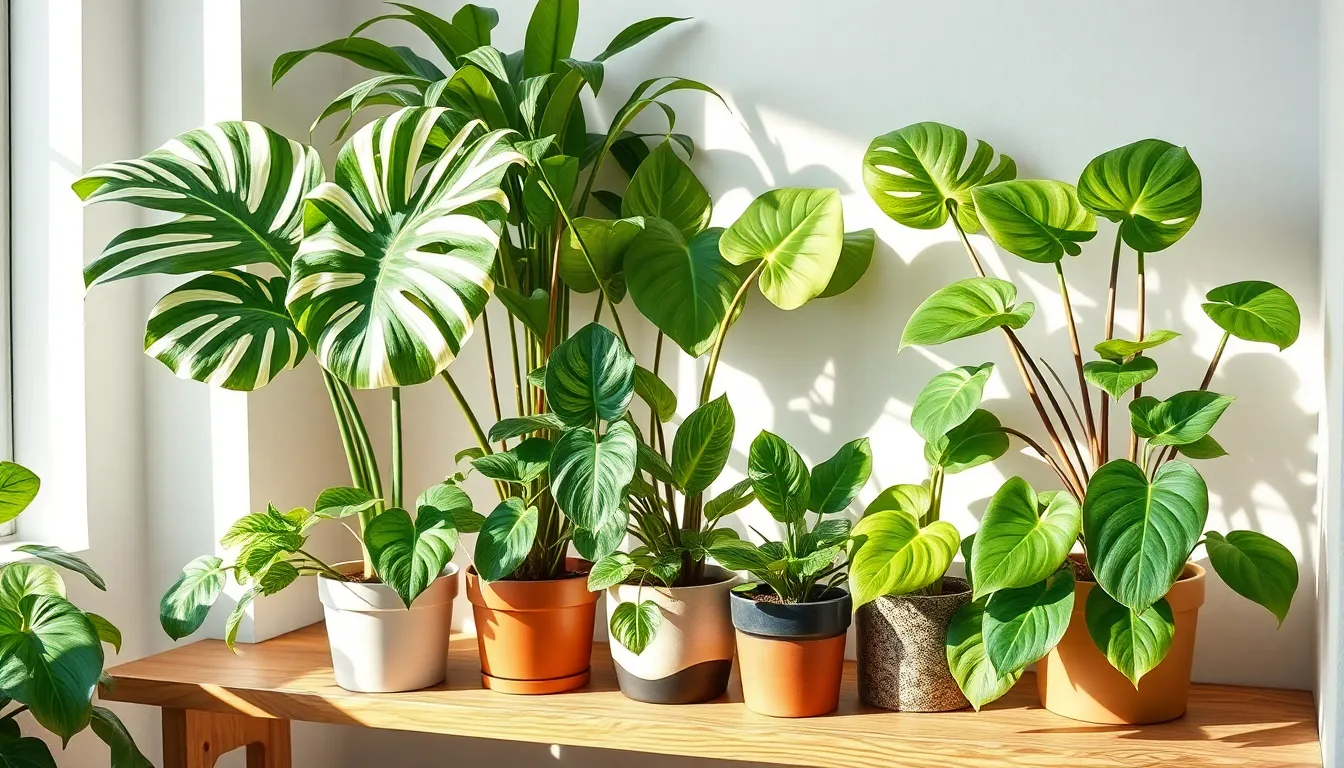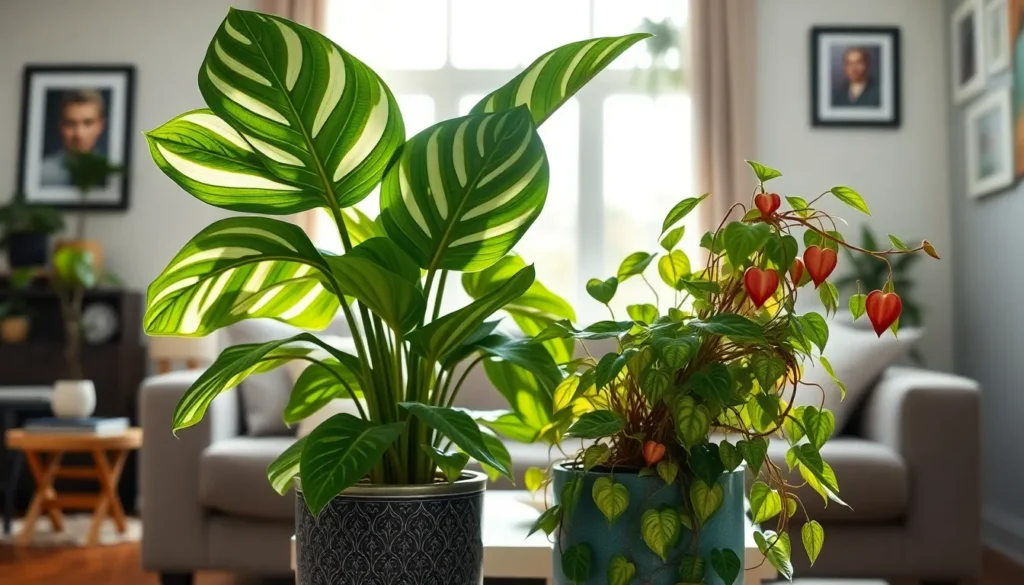In a world where ordinary houseplants are just so yesterday, rare houseplants are the new rock stars of indoor gardening. Imagine strutting through your living room, showcasing a plant that not only turns heads but also sparks envy among friends. These botanical beauties are the ultimate conversation starters, proving that you’re not just a plant parent; you’re a plant connoisseur.
From the elusive Monstera Albo to the stunning Variegated String of Hearts, these rare gems bring a touch of the exotic right into your home. They might require a bit more TLC than your average pothos, but the reward is well worth it. After all, who wouldn’t want to impress guests with a plant that’s rarer than a unicorn in a tuxedo? Dive into the world of rare houseplants and discover how to elevate your green space from basic to breathtaking.
Table of Contents
ToggleOverview Of Rare House Plants
Rare house plants have gained popularity among indoor gardening enthusiasts. Each plant offers unique characteristics and striking visuals, making them desirable for collectors. Some of these plants, such as the Monstera Albo, feature stunning white variegation, while others, like the Variegated String of Hearts, display intricate patterns.
Caring for rare varieties often requires increased attention. These plants may demand higher humidity levels or specific light conditions. With proper care, their beauty can thrive, significantly enhancing a space’s aesthetic appeal. Owners may also seek out rare plants to demonstrate their knowledge and commitment to plant care.
Several factors contribute to a plant’s rarity. Limited availability often stems from specific climate requirements or slow growth rates. Consequently, some rare plants may command higher prices in the marketplace. Collectors prioritize unique specimens, reflecting their commitment to distinctive indoor gardens.
When choosing rare house plants, it’s essential to research their specific needs. Familiarity with the plant’s care regimen can lead to successful growth. Observing common challenges associated with these exotic plants may help prospective owners prepare for potential issues.
Varieties such as the Pink Princess Philodendron and Allocasia Frydek also exemplify this trend. Each plant not only serves as an elegant addition but can also spark conversations among guests. Rare house plants captivate enthusiasts and casual decorators alike with their unique qualities.
Popular Types Of Rare House Plants

Rare house plants come in various types, each possessing unique qualities that appeal to collectors and enthusiasts.
Foliage Plants
Foliage plants are prized for their striking leaf patterns and colors. The Monstera Albo stands out with its white variegation, adding a bold touch to any space. Another notable example, the Alocasia Frydek, features arrow-shaped leaves with prominent veins, making it visually captivating. These foliage plants often require specific care, including bright indirect light and consistent humidity levels. Both varieties can be challenging to cultivate due to their sensitivity to environmental changes. Owning such foliage plants demonstrates a commitment to plant care and a keen eye for aesthetic details.
Flowering Plants
Flowering plants bring bursts of color and vibrancy to indoor collections. Rare examples include the Hoya Kerrii, known for its heart-shaped leaves and occasional clusters of star-shaped flowers. The Variegated String of Hearts also impresses with its delicate pink and green foliage, producing small, charming blooms. Both types thrive in bright, indirect light, making them suitable for various indoor locations. Proper watering routines and ensuring well-draining soil enhances their growth potential. Flowering plants not only enrich home decor but also evoke a sense of joy and vitality through their blooms.
Care Tips For Rare House Plants
Caring for rare house plants involves understanding their unique needs. Attention to detail ensures vibrant growth and longevity.
Light Requirements
Rare house plants thrive in specific light conditions. Bright, indirect light suits most, allowing essential photosynthesis. Too much direct sunlight can scorch delicate leaves. Conversely, insufficient light results in leggy growth and faded colors. Monitor their placement, adjusting as necessary. Some varieties, like the Monstera Albo, adapt well to lower light levels if needed. Knowing the preferences of each species aids in maintaining healthy plants.
Watering Needs
Watering plays a crucial role in the health of rare house plants. Soil moisture requirements vary among species, making it essential to understand individual needs. Many rare varieties prefer slightly moist soil that dries out between waterings. Overwatering can lead to root rot, while underwatering results in wilting. Checking soil moisture with fingers ensures proper care. Using distilled or rainwater enhances plant health by avoiding harmful chemicals found in tap water. Adapting to each plant’s environment promotes lush growth.
How To Source Rare House Plants
Sourcing rare houseplants involves various strategies. Online marketplaces offer access to a wide variety of rare species, including Monstera Albo and Variegated String of Hearts. Websites like Etsy and specialized plant retailers cater to collectors seeking unique additions.
Local nurseries may surprise with their selection of rare plants. Visiting plant shows or expos provides the opportunity to meet breeders and growers who share their expertise. Engaging with plant communities through social media platforms connects enthusiasts and expands sourcing options.
Joining plant clubs often leads to discovering rare species through swaps or sales. Many collectors share tips on sourcing hard-to-find plants. Exploring botanical gardens also yields potential leads, as they often sell rare varieties to support their programs.
Researching plant care guides can aid in locating specific plants. Knowing the characteristics of desired varieties, such as the light and humidity they require, enhances the ability to source them successfully. Attending plant swaps might uncover hidden gems, as enthusiasts exchange their prized specimens.
Networking with local growers can uncover exclusive opportunities. Often, they have limited stock of rare plants not available in mainstream markets. Staying updated on seasonal plant releases keeps collectors informed about new arrivals.
Monitoring auctions and specialty retailers aids in acquiring sought-after plants. Many rare varieties command higher prices based on their limited availability. Collecting resources and maintaining connections ultimately leads to a thriving collection of rare houseplants.
Rare houseplants offer a unique opportunity for plant lovers to elevate their indoor spaces. Their striking aesthetics and distinct features not only enhance home decor but also reflect a dedication to plant care. With the right knowledge and attention, these exotic varieties can thrive and bring joy to any environment.
As collectors explore various sources for these plants, they’re bound to discover a community that shares their passion. By understanding the specific needs of each rare species, they can ensure vibrant growth and longevity. Embracing the challenge of caring for rare houseplants can lead to a rewarding and visually stunning collection that stands out in any home.

